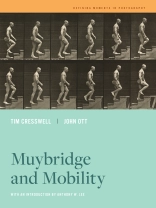A cultural geographer and an art historian offer fresh interpretations of Muybridge’s famous motion studies through the lenses of mobility and race.
In 1878, Eadweard Muybridge successfully photographed horses in motion, proving that all four hooves leave the ground at once for a split second during full gallop. This was the beginning of Muybridge’s decades-long investigation into instantaneous photography, culminating in his masterpiece
Animal Locomotion. Muybridge became one of the most influential photographers of his time, and his stop-motion technique helped pave the way for the motion-picture industry, born a short decade later.
Coauthored by cultural geographer Tim Cresswell and art historian John Ott, this book reexamines the motion studies as historical forms of “mobility, ” in which specific forms of motion are given extraordinary significance and accrued value. Through a lively, interdisciplinary exchange, the authors explore how mobility is contextualized within the transformations of movement that marked the nineteenth century and how mobility represents the possibilities of social movement for African Americans. Together, these complementary essays look to Muybridge’s works as interventions in knowledge and experience and as opportunities to investigate larger social ramifications and possibilities.
Mục lục
Contents
Introduction
Anthony W. Lee
Visualizing Mobility
Tim Cresswell
Race and Mobility
John Ott
Notes
Index
Giới thiệu về tác giả
Tim Cresswell is Ogilvie Professor of Geography at the University of Edinburgh. His most recent books are Maxwell Street: Writing and Thinking Place and a volume of poetry called Plastiglomerate.John Ott is Professor of Art History at James Madison University and author of Manufacturing the Modern Patron in Victorian California. His current book project is Mixed Media: The Visual Cultures of Racial Integration, 1931–1954.












